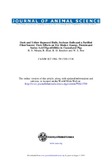Dark And Yellow Rapeseed Hulls, Soybean Hulls And A Purified Fiber Source: Their Effects On Dry Matter, Energy, Protein And Amino Acid Digestibilities In Cannulated Pigs

View/
Date
1984Author
Mitaru, B. N
Blair, R
Reichert, R. D
Roe, W. E
Type
ArticleLanguage
enMetadata
Show full item recordAbstract
Hulls from Tower rapeseed (dark colored
cultivar), R500 rapeseed (yellow colored
cultivar) and soybean were included in semipurified
diets for growing pigs at 10%, to
investigate the effects of these fiber sources on
dry matter, energy and protein digestibilities.
Celufil, a purified fiber source, was also included
in another diet at a 10% level for comparison.
Casein, which was the main protein source, was
added at a 15% level in all the diets. Four 40-kg
barrows fitted with cannulas at the terminal
ileum were used in a digestibility trial with a 4
• 4 Latin square design. The digestibilities of
dry matter, protein and amino acids were
measured to the ends of both the small and
large intestines, while the digestibility of energy
was measured only over the entire gastrointestinal
tract. The true protein digestibility
was also determined at the ileal and fecal levels.
The Celufil diet had a higher cellulose content
(8.7%) than the other diets (2.8 to 5%). The Tower rapeseed hull diet contained the highest
lignin percentage (2.9), while the Celufil diet
had the lowest value (.06). The dry matter
and energy digestibility values were lowest with
the Celufil diet. Highly significant negative
correlations between the digestible energy and
the dietary crude fiber, neutral detergent fiber,
acid detergent fiber and cellulose were respectively
shown. Protein and majority of amino
acid digestibility values were higher (P<.05)
with the Celufil diet than with the hull diets.
The dark rapeseed hull diet had the lowest
protein digestibility value at the terminal
ileum. However, there were no differences
(P>.05) in protein digestibility values for the
hull diets measured over the total digestive
tract. The digestibility values of dry matter,
protein and amino acids were lower at the
terminal ileum than at the fecal level. The
results suggest that cellulose can be included in
swine diets up to 9% without a deleterious
effect on protein and amino acid digestibilities,
although this level will lower dry matter and
energy digestibility values. The lignin content
of the diets and possibly other undetermined
factors appear to have some adverse effects on
protein and amino acid digestibilities.
(Key Words: Rapeseed Hull, Dietary Fiber,
Energy, Protein, Amino Acids, Cannulated
Pigs.)
URI
http://www.animal-science.org/content/59/6/1510.shorthttp://erepository.uonbi.ac.ke:8080/xmlui/handle/123456789/53635
